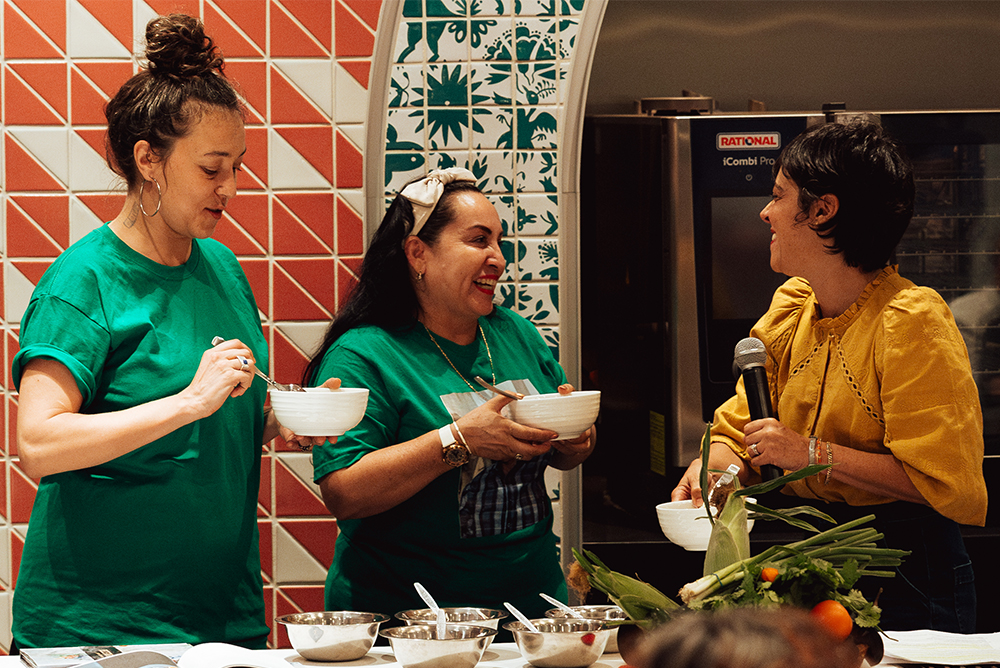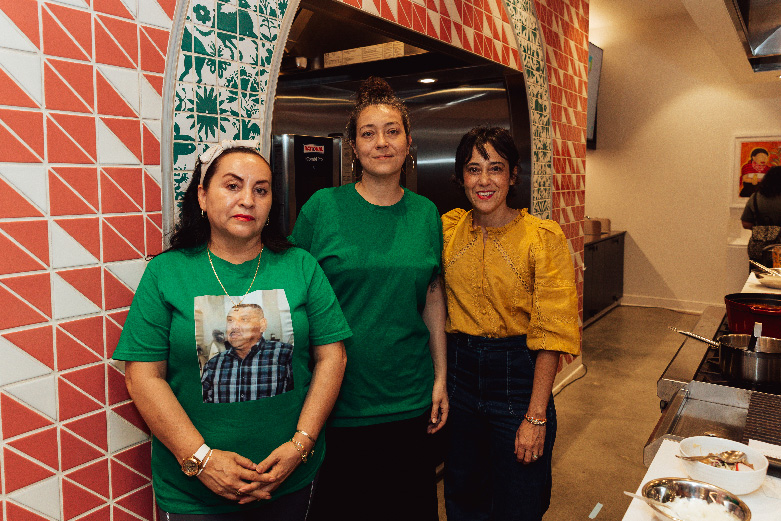
From left to right: Zahara Gómez Lucini, Blanca Soto, and Maite Gomez-Rejón.
“Food can be a strong place to talk about things we don’t want to talk about,” Zahara Gómez Lucini said at last night’s special Zócalo program, “Do We Need More Food Fights?” The event, presented in partnership with LA Cocina de Gloria Molina and California Humanities, was part of Zócalo’s 20th birthday series “What Connects Us?”
Gómez Lucini is the photographer and creator of Recetario para la memoria (The Memory Recipe Book), a cookbook that collects recipes from the families of desaparecidos—the tens of thousands of people who have disappeared in Mexico, many thought to be dead due to state-sponsored or cartel violence.
She was joined on stage at LA Cocina de Gloria Molina’s demonstration kitchen in downtown L.A. by Maite Gomez-Rejón, culinary historian and co-host of the “Hungry for History” podcast. During an emotional conversation streamed in front of a live audience, the two spoke about food, family, and memory, while preparing a recipe from Gómez Lucini’s cookbook, Blanca Soto’s “el pozole para Camilo.”
As Gomez-Rejón got started on the pozole, she gestured to large-scale photos of some of the dishes from the cookbook that lined the wall as part of an exhibition based on the cookbook. “The images are not like looking at a Bon Appetit magazine,” she said. “They’re so full of emotion. It’s this whole idea that cooking isn’t about satiating hunger, or nourishment, it’s something that unites us and, in the case of Recetario para la memoria, reunites us.”
Throwing some hominy, produced from corn, into the pot of boiling water, Gomez-Rejón then shared a little about the dish they were making that night. Pozole is pre-Hispanic, she explained, and is “the soul of Mexico.” Corn, too, she said, encapsulates the spirit of Mesoamerican mythology: “Humans were molded from masa.”
Turning to Gómez Lucini, she asked her to speak about her cookbooks. How did you get started on this project?
For years, Gómez Lucini said, she has been watching groups like the Sinaloa-based Las Rastreadoras del Fuerte, who have been fighting back against government indifference and complicity to search for the bodies of those they love. The tragedy of the desaparecidos is something that she knew about from stories her father, an Argentinian journalist, told her when she was growing up, about the many people who were forcibly disappeared from Argentina during the Dirty War of the 1970s and ’80s.
After moving to Mexico, Gómez Lucini realized that this history was “present” there, too. In 2019, her project got off the ground in Los Mochis, Sinaloa. By training, she was a documentary photographer, but she quickly realized that was not the best way to invite a conversation about the forced disappearance of so many people.
“How can we change the image of the victim? How can we not stigmatize each disappeared and each family looking for them?” she said. “We find that maybe the cook and the hearth of the house can be a way to be aware of the disappearance and to understand we can be part of that.”
How did you gain the trust of these women and families? Gomez-Rejón asked, adding bouillon into the pot with oregano, pepper, and garlic.
Gómez Lucini explained that she first met many of the women who participated in the project years before they collaborated together. “It was very natural in this way.” It was mostly women who went out searching for the disappeared.
Speculating on why it was mostly women who went out searching for the disappeared, Gómez Lucini said, “I think memory is a woman’s territory generally,” Gómez Lucini said. Gomez-Rejón cited other examples of women using the kitchen as activism in the face of government neglect, and even community cookbooks as a form of alternative memory.
As the ingredients started to simmer on stage, Gomez-Rejón brought up the nostalgia and empathy invoked in each photograph of dishes and asked Gómez Lucini about her method when photographing these heartfelt dishes.
“I think it’s to be intimate with each one. To find Camilo in the pozole, or find Roberto in the pizza. To find them in the food,” Gómez Lucini answered.
She noted a moment when she felt the power of these dishes: “When I understood that they didn’t cook the recipe since the disappearance. I think that’s a way to make it alive in some way. And to share the memory and talk about them as a living person and not dead.”
The dishes run from elaborate moles to a simple hard-boiled egg recipe. “All of us have a preferred dish,” Gómez Lucini said. “Maybe not the gastronomical one, but because your mom cooked it for you.”
Gomez-Rejón then invited a special guest, Blanca Soto, whose pozole recipe in honor of her husband, Camilo, was bubbling on the kitchen stove, to join them on stage.
How do you hope the memory of Camilo will live on? Gomez-Rejón asked Soto, who identified her husband’s remains six years ago this September. Soto spoke in Spanish, which Gomez-Rejón translated for the audience. Just by the act of sitting here, the memories of Camilo come back to life, she said, explaining that sometimes Camilo would eat pozole three times a day. He liked it very spicy, because it was “macho.”
Soto wore a green shirt emblazoned with a photograph of Camilo, and on the back the words “PROMESA CUMPLIDA” (Promise Accomplished). Soto explained that women who searched for their loved ones and found their remains wore green—it was the color of hope (they always had the hope their loved ones would be found). But the majority of women, who still search, wear white shirts with the words “I will search for you always” (in Spanish).
The search for closure—for a trace of the missing—can end with as little as a piece of bone. “We don’t look for bones, we look for treasures,” some of the women say.
With the pozole finished, the three women took their first bites. Soto commented how nice it was that somebody else had made it for her this time.





Send A Letter To the Editors